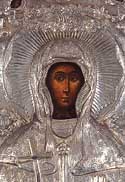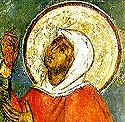|
|||
|---|---|---|---|
| This weekly bulletin insert complements the curriculum published by the Department of Christian Education of the Orthodox Church in America. This and many other Christian Education resources are available at http://dce.oca.org. | |||

When 630 church leaders gathered at the Council of Chalcedon in the year 451, their meeting place was the cathedral dedicated to Saint Euphemia. When they struggled unsuccessfully to resolve a very serious disagreement they turned to her, in a surprising way, for the solution. Euphemia was born in Chalcedon to a senator and his wife. From her early years she was determined to dedicate her life to Christ in virginity rather than marrying and having children. When the pagan governor of Chalcedon demanded that all citizens gather to worship and sacrifice to the gods, some Christians refused, and came together secretly for worship and prayers. One day Euphemia was discovered among a group of Christians worshipping in a house. The soldiers in charge of arresting the Christians tried to flatter her and to talk her into worshipping the pagan gods. "Don't throw your life away," they told her. "You are young and pretty. Is it such a serious matter to say a few prayers to the temple gods?" Euphemia answered at once, "We are not fools. We know the difference between your lifeless statues and the true, living God we worship. Don't waste your time trying to convince us to change our minds!" The soldiers saw that Euphemia gained courage from her fellow Christians. She was the youngest of the group. Perhaps, they thought, she would weaken without the others' support. She might then reveal the names of more Christians they could track down and arrest. So they took Euphemia, alone, to be interrogated. She was cruelly tortured, and died in the arena where Christians often suffered during gladiatorial games. It was about the year 307. Her fellow Christians built a beautiful cathedral over her grave, and that was where the Council of Chalcedon met 144 years later. The meeting didn't go smoothly because the delegates were divided on a central issue. The Monophysites said that if Christ is one Person, He must have only one nature. The Orthodox insisted that Christ is one Person having two perfectly united natures, divine and human. It was finally decided that each group would write a "confession of faith" telling what they believed, on a scroll. The two scrolls were sealed and placed in the tomb of the cathedral's patron, Saint Euphemia. A guard watched over the tomb for three days, while the delegates fasted and prayed.
When the tomb was opened, the scroll detailing the Orthodox position was in Euphemia's right hand, and the other scroll lay at her feet. Euphemia had given the answer: Christ is one Person in two unconfused, undivided and inseparable natures. In Rovinj, Croatia you can climb to the highest point in the city, the top of the Tower of Saint Euphemia. A statue of the saint revolves on the tower. As it turns, the statue's right hand shows which way the wind is blowing, just as Saint Euphemia's right hand showed the way of belief so many centuries ago. |
|||

